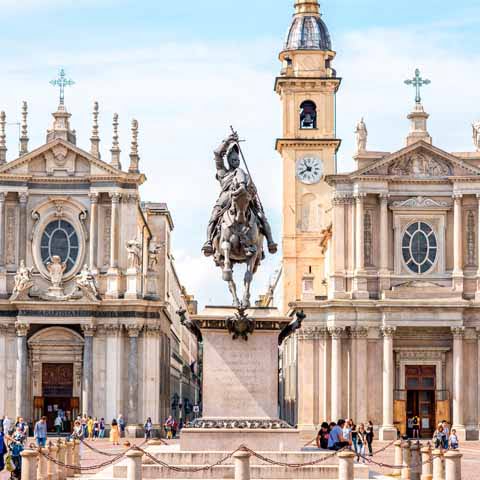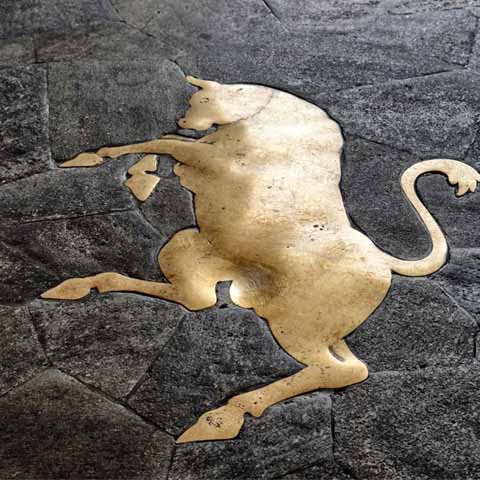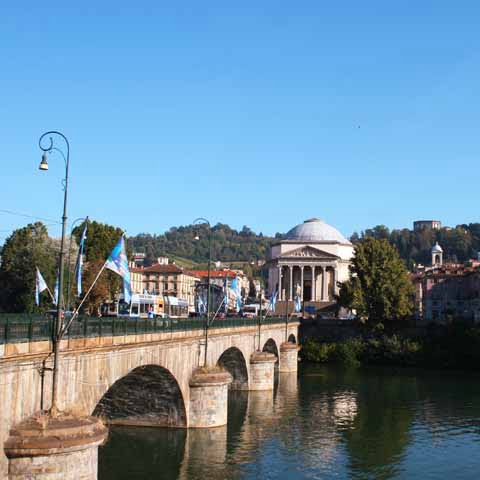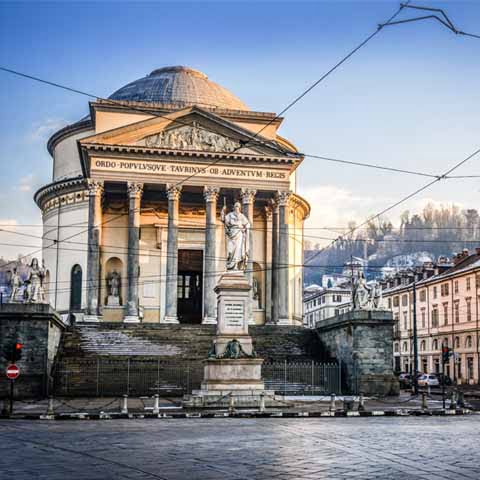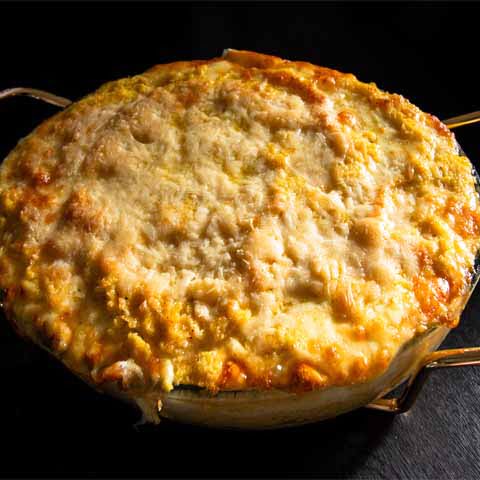As the northwestern jewel of Italy, Turin is a magical city. This impressive and vast city is bursting with culture, from the architecture of historical squares and royal palaces, to a dozen or so art museums, to striking scientific achievements, to a thriving literary community, to the increasingly flourishing cinematic industry. Culture is more than just a feature of Turin; it is a treasured and beloved part of everyday life here.
ARCHITECTURE
The piazze of Italian cities are central open-air squares where people stop to visit, rest, grab a coffee, or just relax and people watch. Turin is home to several large piazze filled with phenomenal architecture. Two of the most important squares of the city are Piazza Castello and Piazza San Carlo. The former is the city’s principal square and the second largest square in Turin. Sitting at the crossroads of the city’s four main streets — Via Garibaldi, Via Po, Via Roma, and Via Micca — Piazza Castello is home to Turin’s most important monuments, including Palazzo Madama, Palazzo Reale, and Teatro Regio.
Piazza San Carlo is another vast square in Turin’s city center. As a popular meeting place for locals and a venue for outdoor events, Piazza San Carlo has earned the nickname “The Living Room of Turin.” Located on Via Roma, which connects the square to Piazza Castello, Piazza San Carlo features two seemingly identical churches plus a monument dedicated to Emanuele Filiberto di Savoia (the sixteenth century Duke of Savoy) and several historic cafés, including Caffè San Carlo, which was frequented by the city’s most important politicians, including Cavour and Giovanni Giolitti.
Both the Church of Santa Cristina and the Church of San Carlo are located within Piazza San Carlo. In fact, the Baroque churches stand side by side. The most unique aspect of these churches and why many speak of them together is because they are outwardly symmetrical. Interestingly, the churches were built in stages, and the façade of Santa Cristina was completed in 1716 following a design by Filippo Juvarra, while the façade of San Carlo was completed in 1834 by architect Ferdinando Caronesi, who copied Juvarra’s design to ensure there was visual harmony in the square.
Both churches’ façades appear gray in color and feature tall columns plus a rectangular entryway. They each have a stained-glass window and a triangular roof topped with a cross. There are slight differences as well. For instance, Santa Cristina’s façade features six statues, while San Carlo’s features two. Additionally, San Carlo has a bell tower, but Santa Cristina does not. Do not to miss the interior of these churches, which feature remarkable details including frescoes by Antonio Mari (Santa Cristina), Stations of the Cross by Luigi Morgari (Santa Cristina), and stunning altarpieces depicting the life of Saint Charles Borromeo (San Carlo).
Palazzo Madama is located within Turin’s Piazza Castello. This beautiful building with a Baroque façade is a UNESCO World Heritage Site and a historical residence of the royal Savoy family. The palace also represents the intersection of 2,000 years of Turin’s history from serving as a Roman city gate to a defensive fortress, royal residence, and, finally, the seat of the first Senate of the Italian Kingdom. The current façade was designed by Filippo Juvarra, while the rear of the building features the brick walls and towers of the historic castle. The interior of the palace is rich in Baroque style, gold accents, and fabulously ornate details. Inside the palace is an art gallery, the Museo Civico d’Arte Antica (Civic Museum of Ancient Art).
Also located in Piazza Castello, Palazzo Reale is the most important of the former Savoy residences located in Turin, and the building represented the power of the House of Savoy for three centuries. Part of the Royal Museums of Turin, the structure features stunning Baroque and Neoclassical elements. The interior is grand and ornate with a staircase designed by Filippo Juvarra, which is considered to be one of the architect’s masterpieces, as well as art by countless painters including Francesco de Mura and Massimo D’Azeglio. In the west wing of Palazzo Reale is the Chapel of the Holy Shroud, which houses the Shroud of Turin — a long piece of cloth featuring a faint image of a man that may be Jesus Christ — and the chapel is connected to the Cathedral of San Giovanni Battista. Surrounding the palace are vast gardens, called the Giardini Reali, which were designed in large part by André Le Nôtre, who also created the gardens of the Palace of Versailles.
Not far from either palace is the Church of San Lorenzo, also located in Piazza Castello. This Baroque style church was established in the late seventeenth century and took almost a dozen years to complete. One of the most remarkable features of the church is the lantern dome, which was designed by architect Guarino Guarini. The dome is at the very top of the building and lets in a great deal of daylight. The architect designed it this way to symbolize that the older we get in life the more spiritual growth we can obtain.
The Turin Cathedral of San Giovanni Battista dates back to the fifteenth century and is the seat of the archbishop of Turin. Featuring both Renaissance and Baroque elements, the church has a wide stairway leading up to the main entrance. The façade of the church is a mix of neutral colored stone and has three archways and two arched windows on the top half and features an adjacent bell tower with Romanesque foundations and an upper part designed by Filippo Juvarra. The cathedral is probably best known for being the location of the famous Shroud of Turin, though it is also the burial place of Blessed Pier Giorgio Frasati and home to several remarkable works of art such as a polyptych by Giovanni Martino Spanzotti and Defendente Ferrari.
The Mole Antonelliana is one of Turin’s most iconic architectural works and has become a symbol of the city. The nineteenth century building was originally a synagogue, yet it was subsequently purchased by the city government to serve as a monument representing national unity. Completed over a course of more than 20 years, the massive structure was designed by architect Alessandro Antonelli, who lent his name to the work. When the Mole Antonelliana was completed, it was the tallest brick building in Europe. One of the most remarkable features of the building is its elevator that in approximately one minute takes visitors to a panoramic terrace situated at just over 270 feet. The building’s tower reaches a height of nearly 550 feet and is the most iconic part of Turin’s skyline. The dome and tower are illuminated with brightly colored lights for special events such as the 150th anniversary of the Unification of Italy and the 50th anniversary of the Apollo Moon Landing. Since 2000, the Mole Antonelliana has been the site of the National Cinema Museum, which chronicles the history of film and Turin’s role in Italy’s cinema industry.
Another secular piece of architecture popularly visited in Turin is the Palatine Gate. Over the years, this gate has been referred to by several names including Porta Comitale, Porta Doranea, Porta Palazzo, and, finally, Porta Palatina. This large city gate of Roman origins is several stories tall and was once a gateway into Turin from the north. Dating back to the first century B.C., the gate is considered to be one of the best surviving examples of a Roman gateway. It features a main archway, a central section with two rows of windows, and two side towers with similar windows.
While the Palantine Gate, piazze, and churches described are all perfect examples of this city’s richness in architecture, from city limit to city limit, Turin is packed with many architecturally impressive historical landmarks.
ART
Art has always been a part of this modern city’s legacy, and today visitors can find a number of museums in Turin that honor and showcase outstanding artistic masterpieces.
The Museo Egizio offers visitors a first-hand view of Egyptian antiquities and is considered to be the most important museum dedicated to the Egyptian civilization outside of the Egyptian Museum in Cairo.
The Museo Civico d’Arte Antica is located in Palazzo Madama and features a collection of medieval, Renaissance, and Baroque paintings. Divided into 35 rooms over four floors plus a panoramic terrace, the museum houses over 70,000 works of art including paintings, sculptures, codices, ceramics, and furniture. Ritratto Trivulzio by Antonello da Messina and Liberazione di San Pietro dal carcere by Giacomo Jaquerio are among the museum’s most celebrated paintings.
The Galleria Civica d’Arte Moderna e Contemporanea is a marvelous place to see some of the more modern Italian art collections. In fact, this was Italy’s first museum dedicated to the public display of modern art. The museum spans four floors and is divided by movements including Divisionism, Futurism, Abstract Art, Pop Art, and Arte Povera (a movement focusing on simple and meaningful art that began in Turin). The earliest works displayed are paintings and sculptures from the second half of the nineteenth century. Several great Italian artists are represented alongside foreign artists including Giorgio de Chirico, Umberto Boccioni, Giacomo Balla, Max Ernst, and Paul Klee. The museum features fascinating temporary exhibitions and it is a noted center for contemporary art hosting workshops and special events throughout the year.
Just outside of the main city center, travelers will find Lingotto, which was once the Fiat car factory. Located in a district of the same name, today Lingotto hosts Fiat’s administrative headquarters and it is also a mixed-use center featuring a mall, convention center, theater, and hotel. On the rooftop, curious travelers can admire the original Fiat test track as well as panoramic views of Turin. For art lovers though, the biggest draw is the Pinacoteca Giovanni e Marella Agnelli, an art gallery located on the top floor of the complex. Here, remarkable works of art from the collection of Giovanni Agnelli (former head of Fiat) and his wife Marella Agnelli are on display. Spanning from the eighteenth to the middle of the twentieth century, the collection features works by renowned Italian and international artists including Amedeo Modigliani, Canaletto, and Matisse. Must-sees include masterpieces by Picasso, Renoir, Manet, and famed sculptor Antonio Canova.
If you have a preference for ancient art, head to the Museum of Antiquity located on the grounds of Palazzo Reale. The core artifacts are from the collections of the Dukes of Savoy, which date back to the sixteenth century. Among the works on display are Greek and Roman mosaics, sculptures, and ceramics as well as Etruscan and Cypriot artifacts. There is also a pavilion dedicated to local archeology with more than 8,000 objects tracing the history of the Piedmont region from prehistoric times to the Middle Ages.
Last, but not least, the Biblioteca Reale, which is the Royal Library housed inside of Palazzo Reale, displays what many believe to be a self-portrait of Leonardo da Vinci. Drawn in red chalk, the portrait depicts an elderly man with a long beard. Not all art historians agree that the self-portrait was created by Leonardo himself, nonetheless the drawing has become the iconic representation of Leonardo da Vinci from which our current image of the great artist’s physical appearance derives.
SCIENCE
In addition to its stunning art and architecture, Turin has been the site of several scientific innovations over the course of history.
It was in Turin that Charles Babbage presented his first prototype for a mechanical computer at a scientific conference in 1840. Turin is also where Galileo Ferraris invented the AC three-phase induction motor during the nineteenth century. Approximately 90 years later, Turn become the first city in the world to have an urban fiber optic network, which spanned five and a half miles. Turin was also the home of Pier Giorgio Perotto, inventor of the Olivetti Programma 101, one of the first programmable calculators.
Today, Turin is an important center for scientific research and innovation. The city hosts several key institutes of scientific research including the Accademia delle Scienze di Torino (the Turin Science Academy, which dates back to 1757), as well as the Institute for Scientific Interchange, Accademia di Medicina di Torino (Turin Medical Academy), and Telecom Italia Lab (telecommunications research), among others.
LITTERATURE
Turin has been a haven for writers for centuries, and the city was designated as the World Book Capital by UNESCO in 2006. The city has yielded a number of influential writers whose works are prominent still today.
Emanuele Tesauro was a seventeenth century poet born in Turin. Tesauro was known for his studies of spirituality and he worked as a priest in addition to writing. During his lengthy literary career, he wrote a number of different types of works including poems, tragedies, and histories. Some of his most recognized works include Il cannocchiale aristotelico and Del Regno D’Italia sotto i barbari.
Although eighteenth century dramatist and poet Vittorio Alfieri was not born in Turin, he did study here from a young age. He traveled Europe throughout much of his younger years and returned to Turin later in life where he is said to have fallen in love with Marchesa Turinetti di Prie. During his courtship of the woman, he wrote a drama that eventually became known as Cleopatra when it was performed in Turin in the late eighteenth century. An avid poet and dramatist, Alfieri is considered to be the “founder of Italian tragedy.”
Guido Gozzano was primarily a nineteenth century Italian writer and poet born in Turin. A man of fragile health, he became a writer and eventually ventured into writing short stories for film production. Although Gozzano did write poetry and prose, perhaps one of his best-known works, Lettere d’amore di Guido Gozzano e Amalia Guglielminetti, is simply a collection of love letters he once exchanged with fellow poet Amalia Guglielminetti.
Italian chemist, Holocaust survivor, and writer Primo Levi was born in Turin and graduated from the University of Turin. After surviving Auschwitz, Levi wrote his first book Se questo è un uomo (If This Is a Man), which is a memoir of his time at the concentration camp. As Levi’s most famous and critically acclaimed book, Se questo è un uomo is still widely studied in Italian schools and read worldwide. His other works include La tregua (The Reawakening), a sequel to his first book that chronicles the liberation of Auschwitz as well as the author’s return to Turin, and Il sistema periodico (The Periodic Table), a collection of 21 autobiographical short stories each connected to a particular element.
Although not born in Turin, Giovanni Arpino was a twentieth century writer who lived much of his life in the city. Arpino enjoyed writing on a variety of subjects including everything from sports articles for daily newspapers to novels, poems, plays, and children’s stories. Several of his works have been adapted into films, most notably Un delitto d’onore, which served as the basis for Divorzio all’italiana (Divorce Italian Style) and Il buio e il miele, which was made into the Italian film Profumo di donna that in turn inspired the 1992 American remake Scent of a Woman starring Al Pacino and Chris O’Donnell.
Turin is also the birthplace of Italian writer Paolo Giordano, best known for his internationally acclaimed debut novel La solitudine dei numeri primi (The Solitude of Prime Numbers), which is set in Turin and won the Strega Prize in 2008. The novel was also adapted into a film in 2010.
MUSIC
One of the most beautiful settings for music and the performing arts in Turin is the Teatro Regio. It is among the most highly acclaimed opera houses worldwide and was declared a UNESCO World Heritage Site at the end of the twentieth century. Teatro Regio’s design is refreshingly simple with clean lines, but it is no less grand in its overall effect. Most notably, Teatro Regio hosted the premiere of Giacomo Puccini’s La Bohème in 1896.
The theater was established in the mid eighteenth century, yet the original structure was destroyed during a fire in 1936. The new theater, which was rebuilt behind the original façade, was inaugurated in 1973 with a performance of I vespri siciliani by Giuseppe Verdi. Today, the theater’s opera season typically lasts from October to June and it is the site for countless musical productions such as concerts, opera, ballet, and even lectures.
Turin is also the hometown of singer-songwriters Fred Buscaglione and Umberto Tozzi as well as musical group Cantacronache.
CINEMA
Many consider Turin to be the city where Italian cinema was born. Thanks to Turin’s ties to France, the first Italian movie screening is thought to have taken place here in the late nineteenth century. As time progressed, the next century saw more Italian films debuted in the city. One of these films was Giovanni Pastrone’s Cabiria which came to be one of the first true Italian cinematic blockbusters.
With the cinematic industry flourishing in the early twentieth century, Ambrosio Film was established in Turin. This film company’s existence intrigued others in the industry, which in turn made Turin a much sought-after filmmaking destination until the company closed in 1924. Though Turin’s role in film production diminished after the 1937 inauguration of Cinecittà Studios in Rome (which quickly became the hub of Italian cinema), cinema continued be a key part of Turin’s culture and the city became home to the National Museum of Cinema (located in the Mole Antonelliana since 2000) as well as the Torino Film Festival. Today, Turin remains as one of Italy’s main cinematographic centers.
Notable movies filmed at least in part in Turin include Cabiria (1914), War and Peace (1956), The Italian Job (1969), Profumo di donna (1974), La donna della domenica (1975), Profondo Rosso (1975) Hannah and Her Sisters (1986), Stanno tutti bene (1990), Santa Maradona (2001), Heaven (2002), The Stone Merchant (2006), The Bourne Ultimatum (2007), Il divo (2008), Vincere (2009), La solitudine dei numeri primi (2010), Benvenuto Presidente! (2013), and The King’s Man (2021).
The stately city of Turin is, without a doubt, one of Italy’s most influential cities from a cultural perspective. From the iconic architecture of the Mole Antonelliana and the ornate royal palaces of the House of Savoy to the city’s prestigious role as a center for theater and cinema, Turin is an excellent place for cultural immersion, Italian style.
The Cities of Piedmont, Italy
Don't just see Italy, live it.
Your dream trip to Italy has never been closer
No more endlessly scrolling travel sites. Our travel experts will craft the perfect, one-of-a-kind trip just for you.

300+
DESTINATIONS
We offer more Italian destinations than any travel site. Do and see more with Trips 2 Italy.
1 (of a kind)
ITINERARIES
Because your dream trip to Italy should be designed for you, not for the masses.
100%
PEACE OF MIND
From flights and accommodations, to food and activities - we take care of every detail.

